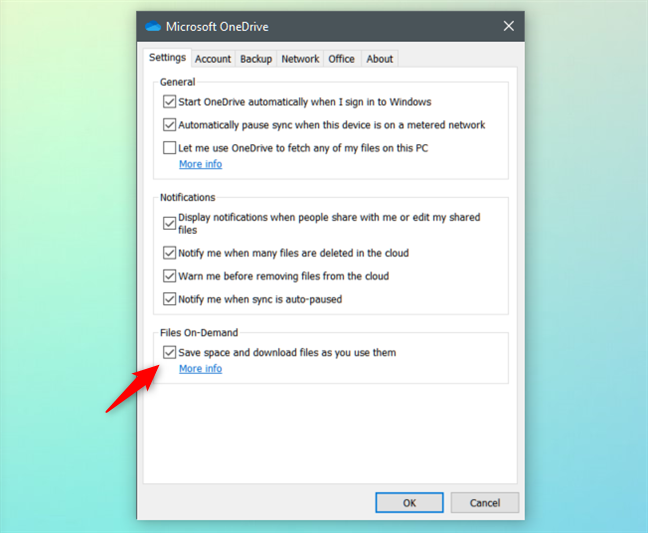
- HOW TO ENABLE ONEDRIVE FILES ON DEMAND WINDOWS 10
- HOW TO ENABLE ONEDRIVE FILES ON DEMAND PLUS
- HOW TO ENABLE ONEDRIVE FILES ON DEMAND PROFESSIONAL
- HOW TO ENABLE ONEDRIVE FILES ON DEMAND DOWNLOAD
Microsoft should simply include functionality within File Explorer to restrict the search to Local files instead of searching the files over the internet. Strangely the solutions to fix the SLOW Search should be quite simple. Is there someone at the steering wheel of Microsoft interested in fixing these problems? Is this a joke or is Microsoft even interested in providing proper real world business solutions? I opened a ticket for “Office for Business” and the workaround I was told was to “close OneDrive”… and then do the search. If Office 365 for Business cannot do a “simple search task” and restrict the search to local files like this, is it really “Fit for Purpose” ? And wait… and wait…īefore any Microsoft Support person replies to say they have tested this using a crummy test environment with a few GB in size (or likely less) please test this with using a normal business environment with at least 300 GB of files and hundreds of thousands of files and many thousands of folders… and also a reasonably slow internet connection. Any search you do has t access the internet… wait for the search to upload… queue up the search command on some server in the Cloud…. This is because if you use OneDrive for Business…. Now a simple search can take over 5 minutes. This is a simple everyday task that I do many times a day that used to take a maximum of a few seconds before signing up for Office 365 for Business.
HOW TO ENABLE ONEDRIVE FILES ON DEMAND PLUS
My files are stored locally on the fastest 1TB SAMSUNG 970 EVO PLUS M.2 and should take less than 10 seconds for any search… and this is how searches used to work until I signed up for Office 365 for Business 2 months ago.īut I cannot restrict search using Windows File Explorer… to ONLY search my local files? 300 GB of them.Īll these files are stored locally as well as on the internet.

All My Documents files are within OneDrive for business… approx.

I have an i7 6 core computer and running Office 365 for Business.
HOW TO ENABLE ONEDRIVE FILES ON DEMAND WINDOWS 10
When I search for files using Windows File Explorer on Windows 10 it is agonizingly slow. Here is one data point from the popular OneDrive forum hosted by UserVoice:Įven if you disable “Files on demand”, searching files using OneDrive for Business is painfully slow and “Not Fit for Purpose” Several folks experiencing slowness were able to speed things up by disabling Files On-Demand. Complaints of slow uploads with Files On-Demand It would be a disaster in an office where OneDrive is mapped to a shared folder because the files not downloaded would never fully show up on the shared drive!Īnd furthermore, as Microsoft mentions, “you cannot search the contents within online-only files because they aren’t stored on the device” - a potential deal-breaker in a commercial environment.
HOW TO ENABLE ONEDRIVE FILES ON DEMAND PROFESSIONAL
However, please be cautious when considering Files On-Demand in a professional setting. It’s a fine choice for individuals/hobbyists looking to conserve precious resources.
HOW TO ENABLE ONEDRIVE FILES ON DEMAND DOWNLOAD
At best you wait a few seconds for the download to complete and the file to open at worst you can’t retrieve the document because you are not connected to the Internet.Īs contributor Craig Long points out, “Files On-Demand is for those who have limited space available or for those who only occasionally need to open a file”. With Files On-Demand enabled, double-clicking the PowerPoint issues a command to the cloud to dynamically download the file.

The document loads quickly because it is already on your computer. Without Files On-Demand, you simply double-click the file and away you go. Your hard drive stores 10 MB less - great.īut the downside of Files On-Demand becomes evident when you need to use the file. With Files On-Demand, OneDrive will “know about” the file but will not automatically transfer it. Without Files On-Demand, that document will be automatically copied to your computer, immediately consuming 10 MB on your hard drive. For example, let’s say you have a 10 MB PowerPoint presentation in the cloud. Files On-Demand trades space for speed of access.


 0 kommentar(er)
0 kommentar(er)
